wheel size AUDI A5 CABRIOLET 2011 Owners Manual
[x] Cancel search | Manufacturer: AUDI, Model Year: 2011, Model line: A5 CABRIOLET, Model: AUDI A5 CABRIOLET 2011Pages: 364, PDF Size: 86.48 MB
Page 206 of 364
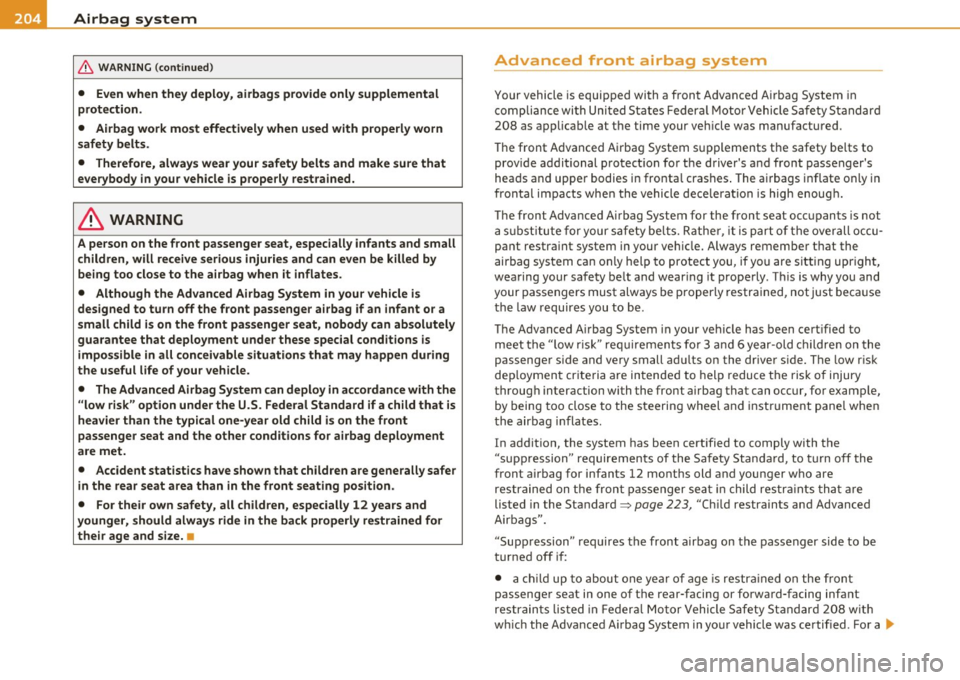
111,___A_ i_rb _ a_,g=-- s_, y:;.. s_ t_e _m ________________________________________________ _
& WARNING (conti nued)
• Even when they deploy, airbags provide only supplemental
protection.
• Airbag work most effectivel y when used with properly worn
safety belts .
• Therefore, always wear your safety belts and make sure that
everybody in your vehicle is properly restrained.
& WARNING
A person on the front passenger seat , especially infants and small
c hildren, will receive serious injuries and can even be killed by
being too close to the a irbag when it inflates .
• Although the Advanced Airbag System in your vehicle is
designed to turn off the front passenger airbag if an infant or a
small child i s on the front pa ssenger seat, nobody can absolutely
guarantee that deployment under these spec ial conditions is
impos sible in all conceivable situations that may happen during
the useful life of your vehicle .
• The Advanced Airbag System can deploy in a ccordance with the
" low risk" option under the U.S . Federal Standard if a child that is
heavier than the typical one-year old child is on the front
passenger seat and the other conditions for airbag deployment
are met.
• Accident statistics have shown that children are generally safer
in the rear seat area than in the front seating po sition .
• For their own safety , all children , especially 12 years and
younger, should alway s ride in the back properly re strained for
the ir age and size. •
Advanced front airbag system
Your vehicle is equipped with a front Advanced A irbag System in
comp li a nce wi th Unit ed State s F edera l Motor Vehicle Sa fety Sta ndar d
208 as applicable at t he time your veh icle was manufactured.
Th e front A dvanced A irbag System s upplements the safety belts to
prov ide addit ional p rotect ion fo r the driver's a nd front passenger's
hea ds and uppe r bodies in fronta l crashes . The airbags inflate only in
fronta l impa cts when the vehicle dece leration is high enoug h.
T he front Advanced Airbag System for the front seat occupants is not
a subs titu te for your s afe ty be lts. R athe r, it is part o f the ove rall occu
pant restra int system in your ve hicle. Always remember t hat the
airbag sys tem ca n on ly hel p to protect you, if yo u are sitting upr igh t,
wearing your safety be lt and wear ing it prope rly . T his is why you and
your passengers must always be p roperly restra ined, not just beca use
t he law requires you to be .
The Advanced A irbag System in your veh icle has been cert ified to
meet the " low r isk " req uirem ents fo r 3 a nd 6 year-old childre n on the
passenger s ide and very small adu lts on the driver s ide. T he low r isk
dep loyme nt crite ria are in tende d to hel p r educe t he ris k of injury
throug h interaction with the front airbag that can occur, for example,
by being too close to the steering wheel and instr ume nt pane l whe n
t he airbag i nflates.
In addit ion, the system has been cert ified to comply with t he
"supp ression" requirements of the Safety Stand ard, to turn off the
front airbag for infants 12 mont hs old and younger who are
res trained on the fron t passenger sea t in child re strai nts th at ar e
listed in the Standard~
page 223, "Child restraints and Advanced
Air bags".
" Sup pression" requ ires the front a irbag on the passenger side to be
turned off if:
• a chi ld up to about one year o f age is restra ined on the fron t
passenge r seat in one of t he rear-faci ng or forward-facing infant
res train ts lis ted in F eder al Motor Vehicle S afety Stand ard 208 wit h
w hich the Advanced A irbag System in yo ur vehicle was ce rtified . Fo r a .,_
Page 224 of 364

____ C_h _i_ld _ S_a _f ...;.e ....:t "- y ________________________________________ _
& WARNING (conti nued)
• Alway s in stall rearwa rd-facing child safety seats on the rear
seat.
• If you must install a rearward facing child safety seat on the
front passenger seat in exceptional circumstance s and the
PASSENGER AIR BAG OFF light does not come on and stay on ,
immed iately install the rearward-facing child safety seat in a rear
seating position and have the airbag system inspected immedi
ately by your authorized Audi dealer .
& WARNING
If, in exceptional circumstances, you must install a forward-facing
child res traint on the front pas senger's seat:
• Always make sure the forward-facing seat has been designed
and certified by it s manufacturer for use on a front seat with a
passenger front and side airbag.
• Always follow the manufacturer 's instruction s provided with
the child safety seat or carrier.
• Always move the passenger seat into it s rearmost position in
the seat 's fore and aft adjustment range, as far away from the
airbag as possible before installing the child restraint. The back rest must be adjusted to an upright position.
• Always make sure that the PASSENGER AIR BAG OFF light
comes on and stays on all the time whenever the ignition is
switched on .•
Advanced front airbag system and children
Your vehicle is equi pped wi th a fron t "Advanced Airbag System" in
compliance with United States Federal Motor Vehicle Safety Standard
( F MVSS) 2 08 as appli ca ble at t he time your ve hicle was manufa c
tured. The Advanced A
irbag system in yo ur vehicle has been certif ied to
mee t the "low -r is k" requiremen ts fo r 3-and 6-ye ar old ch ildre n on
t he passenger side and small adults on the dr iver side . The low risk
dep loyment criteria are inten ded to reduce the risk of injury through
interaction with the a irbag t hat can occur, for example, by being too
close to the stee ring wheel an d instr ument panel when the airbag
inflates. In addi tion, the system has been certified to comp ly with t he
"suppression" requirements of the Safety Standa rd, to t urn off the
fron t air bag for infan ts up to 1 2 months who a re res train ed on the
front passenger seat in child restrai nts that are listed in the Stan
d ar d.
Even thoug h your vehicle is equipped with an Advanced Airbag
system , a ll ch ildren, especially those 12 years and yo unger, should
always r ide in t he back seat p roperly restrained for t heir ag e and si ze .
Th e ai rbag on the passenge r si de makes the front seat a potentia lly
dange rous p lace for a child to r ide. Th e front seat is not th e safest
place fo r a child in a forward-facing c hild safety seat. It can be a very
d an ge rous p lace for a n infan t or a large r chil d i n a rea rwa rd-facing
seat. •
Advanced Airbags and the weight-sensing
mat in the front seat
Th e Advanced A irbag System i n your ve hicle de tects t he p resence o f
an infa nt o r ch ild in a child rest rai nt on the fro nt passenger sea t using
the we ight-sens ing mat in the seat cushion and the senso r be low the
saf ety belt la tch o n th e front passenge r seat tha t measur es t he
tension on the safety belt.
Th e weigh t-sens ing ma t me asures tot al we ight of the child and the
child safety seat and a child blanket on the fro nt passe nger seat . The
we ight on the fro nt passenger se at is re lated to t he design of the
child res traint and i ts "footpri nt", the size and shape of t he bottom
of the ch ild restraint as it sits o n the seat . The weight of a child
restrain t an d its "foo tpr int" vary for differe nt k inds of child res tra ints .,_
Page 249 of 364
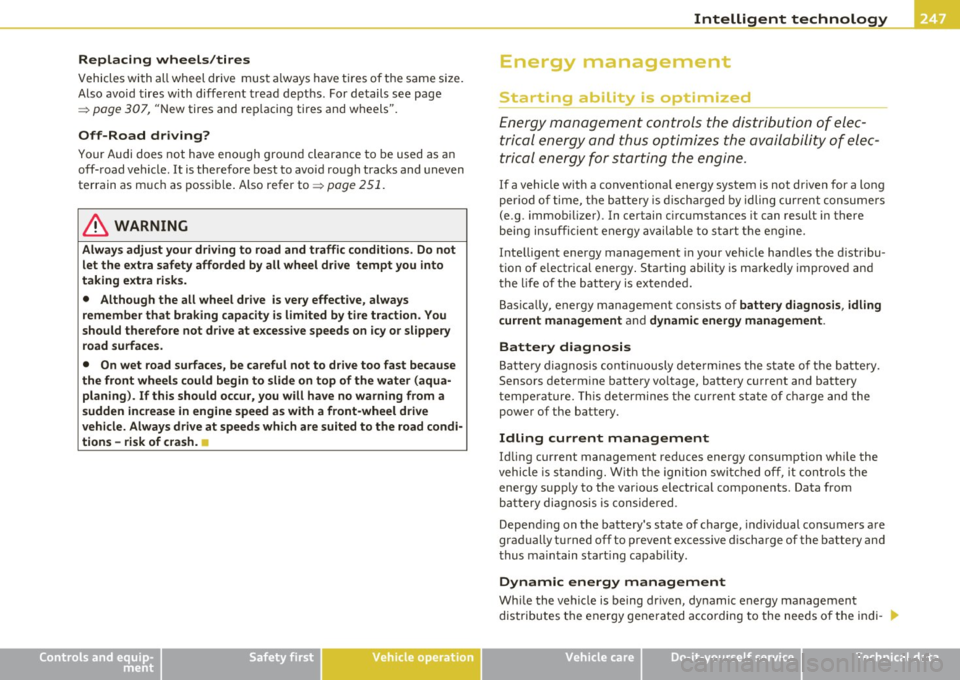
Intelligent technology
--------------------------------------------------' "---.L=.c=--
Repl acing wheel s/tires
Vehicles wi th all wheel drive must a lways have tires of t he same size.
Also avoid tires with different tread depths. For details see page
=> page 307, "New tires and rep lacing tires and wheels".
Off -Road driving?
Your Audi does not have enough ground clearance to be used as an
off-road veh icle . It is therefore best to avo id ro ugh tracks and uneven
terrain as m uch as possible . Also refer to=>
page 251.
& WARNING
Alway s adju st your driving to road and traffi c conditi ons. Do not
let the ex tra safety afforded by all wheel dr ive tempt you into
taking extra risks.
• Although the all wheel dri ve is ve ry effecti ve, always
remember that braking capacity is limited by tire traction. You
should therefore not dri ve at ex cessive speeds on icy or slippery
road surfaces .
• On wet road surfaces , be careful not to drive too fast because
the front wheel s could begin to slide on top of the water (aqua
planing ). If th is should occur, you will have no warning from a
sudden increase in engine speed as with a front-wheel drive
vehicle. Always drive at speeds which are suited to the road cond i
tions -ris k of crash.
n
Controls and equip
ment Safety first Vehicle operation
Energy management
Starting ability is optimized
E
nergy management contr ols th e distributi on of elec
tri cal energy and thus optimizes the availabili ty of elec
tri cal energ y for star ting the engin e.
If a vehicle with a conventiona l energy system is not dr iven for a long
per io d of time, t he battery is di sch arged by idling cur rent consume rs
(e .g. immob il izer) . In certain c ircumstances it can result in there
being insuffic ien t energy av a ilab le to start t he eng ine .
Inte lligent energy management in your ve hicle hand les the d istribu
tion of e lectrical energy . Starting ability is ma rkedly improved and
the l if e of the battery is extended.
Bas ically, energy management consists of
battery d iagnos is, idling
current management
a nd dynamic energy management .
Battery diagnosis
Battery d iagnosis con tinuously dete rmines the st ate o f the batte ry.
Sensors determ ine battery vo ltage, battery current and battery
t empe ra ture. This de termine s the cur rent sta te of cha rge and the
power of the battery.
Idling current management
I d ling current management reduces energy consumption wh ile the
vehicle is s tanding. W ith t he igni tion swi tched off, it con trols the
energy supply to the var io us electrical components. Data from
b att ery diag nosis is considered .
Depend ing on the battery 's state of charge, individual consumers a re
gradually t urned off to p revent excessive discha rge of the battery and
thus main tain start ing capab ility.
Dynamic energy management
Whi le the vehicle is being dr iven , dynamic energy management
dis tributes the energy generated a cco rding to the needs o f th e in di-
Vehicle care Do-it-yourself service Technical data
Page 299 of 364
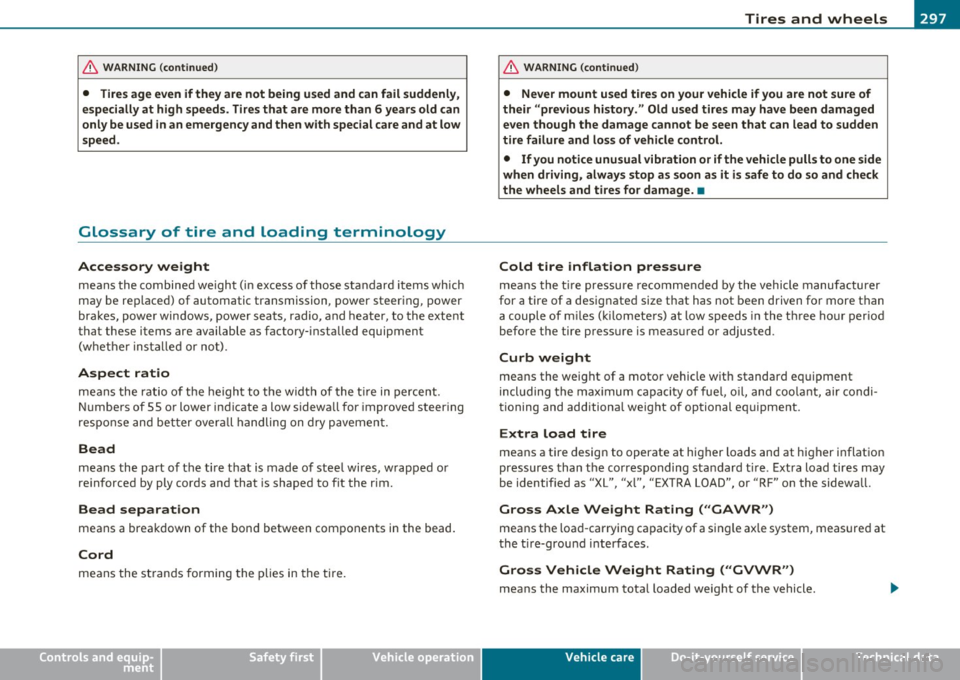
________________________________________________ T_i_re _ s_ a _ n_d_ w_ h_ e_ e_l_s __ l!'II
& WARNING (co ntinued )
• Tires age even if they are not be ing used and can fail suddenly ,
e specially at high speeds . Tires that are more than 6 year s old can
only be used in an emergency and then with special care and at low
s peed .
Glossary of tire and loading terminology
Accessory weight
means the combined weigh t (in excess of those sta ndard items wh ich
may be replaced) of automatic transmission, power steer ing, power
bra kes, powe r win dows, power sea ts, radio, and heate r, to the exte nt
that these items are available as factory-insta lled equipment
(whet her i ns ta lled or no t).
Aspect ratio
means the r atio of t he he ight to t he widt h of the t ire in percent.
N umbers of 55 or lower indicate a low sidewa ll for improved steer ing
res ponse and bet ter over all h andling on dry p avemen t.
Bead
means the part of the t ire that is made of stee l wi res, w rapped or
re in forced by ply cords and that is shaped to fit the rim.
Bead separation
means a brea kdown of the bond between components in the bead.
Cord
means the st rands forming the plies in the ti re.
Safety first
& W ARNING (co ntinued )
• Never mount u sed tires on your vehicle if you are not sure of
their "previous history ." Old u sed tires may have been damaged
eventhoughthedamagecannotbeseenthatcanleadtosudden
tire failure and loss of vehicle control.
• If you notice unusual vibr ation or if the vehicle pulls to one side
when driving, always stop as soon as it is safe to do so and check
the wheels and tires for damage. •
Cold tire inflation pressure
means the t ire pressu re recom mended by the vehicle manufa ctu rer
for a tire of a desig nate d size that has not been driven for more than
a couple of m iles ( kilomete rs) a t low speeds in the t hree hour per io d
before the tire pressu re is measured or adjusted.
Curb weight
means the weight of a moto r vehicle wit h standard equipment
incl uding the max imum ca pac it y of fue l, o il, and coo lan t, air condi
tioning and additiona l weig ht of optional eq uipment.
Extra load tire
means a tire design to operate at higher loads and at higher inflat ion
pressures than t he co rresponding sta ndard t ire. Extra load tires may
be identif ied as "XL", "xl", "EXTRA LOAD", or "RF" on the sidewa ll.
Gross Axle Weight Rating ( "GAWR ")
means the loa d-carrying capac ity of a sing le ax le system, measure d at
the t ire-grou nd interfaces.
Gross Vehicle Weight Rating ("GVWR")
mea ns the maximum tota l loaded we ig ht of the vehicle .
Vehicle care Technical data
Page 300 of 364
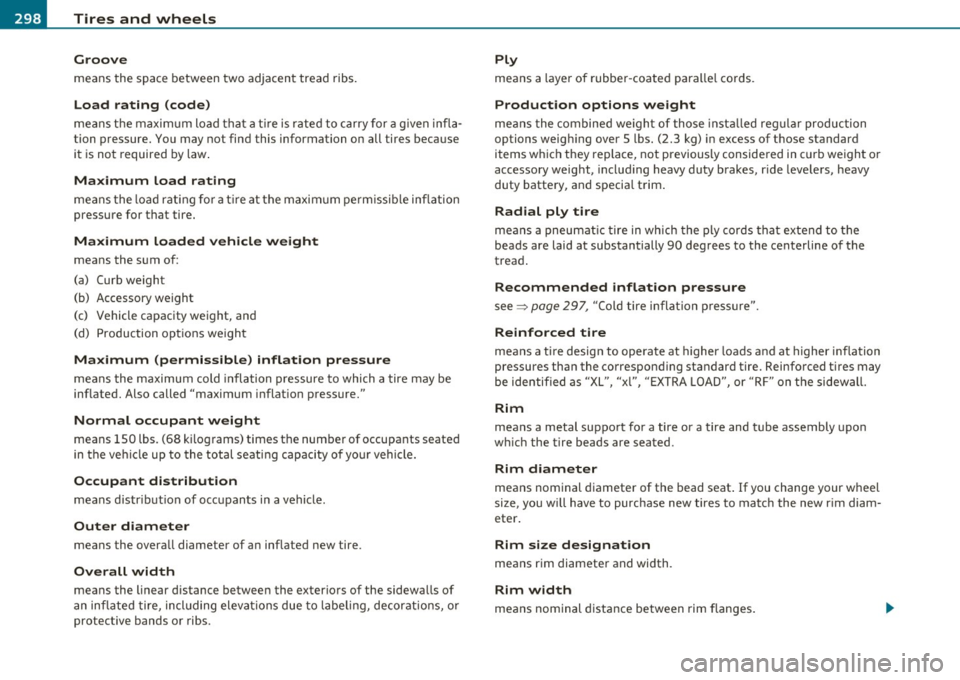
-~_T_ ir_e_ s_ a_ n_ d_ w_ h_e_ e_ ls _______________________________________________ _
Groove
means the space between two adjacent tread ribs.
Load rating (code)
means the maximum load that a tire is rated to carry for a given infla
tion pressure. You may not find this information on all tires because
it is not required by law.
Maximum load rating
means the load rating fo r a tir e at the maximum permissible inflation
pressure for that tire.
Maximum loaded vehicle weight
means the sum of:
(a) Curb weight
(b) Accessory weight
(c) Vehicle capacity weight, and
(d) Production options weight
Maximum (permissible) inflation pressure
means the maximum cold inflation pressure to which a tire may be
inflated. Also called "maximum inflation pressure."
Normal occupant weight
means 150 lbs. (68 kilograms) times the number of occupants seated
in the vehicle up to the total seating capacity of your vehicle.
Occupant distribution
means distr ibution of occupants in a vehicle .
Outer diameter
means the overall diameter of an inflated new tire.
Overall width
means the linear distance between the exteriors of the sidewalls of
an inflated tire, including elevations due to labeling, decorations, or
protective bands or ribs.
Ply
means a layer of rubber -coated paralle l cords.
Production options weight
means the combined weight of those installed regular production
options weigh ing over 5 lbs. (2.3 kg) in excess of those standard
items which they replace, not previously considered in curb weight or
accessory weight, including heavy duty brakes, ride levelers, heavy
duty battery, and specia l trim .
Radial ply tire
means a pneumatic tire in which the ply cords that extend to the
beads are laid at substantially 90 degrees to the centerline of the
tread .
Recommended inflation pressure
see=> page 297, "Cold tire inflation pressure".
Reinforced tire
means a tire design to operate at higher loads and at higher inflation
pressures than the corresponding standard tire. Reinforced t ires may
be identified as "XL ", "x l", "EXTRA LOAD", or "RF" on the sidewall.
Rim
means a metal support for a tire or a tire and tube assembly upon
wh ich the tire beads are seated .
Rim diameter
means nominal diameter of the bead seat . If you change your wheel
size, you w ill have to purchase new tires to match the new rim diam
eter .
Rim size designation
means rim diameter and width.
Rim width
means nominal distance between rim flanges.
Page 303 of 364
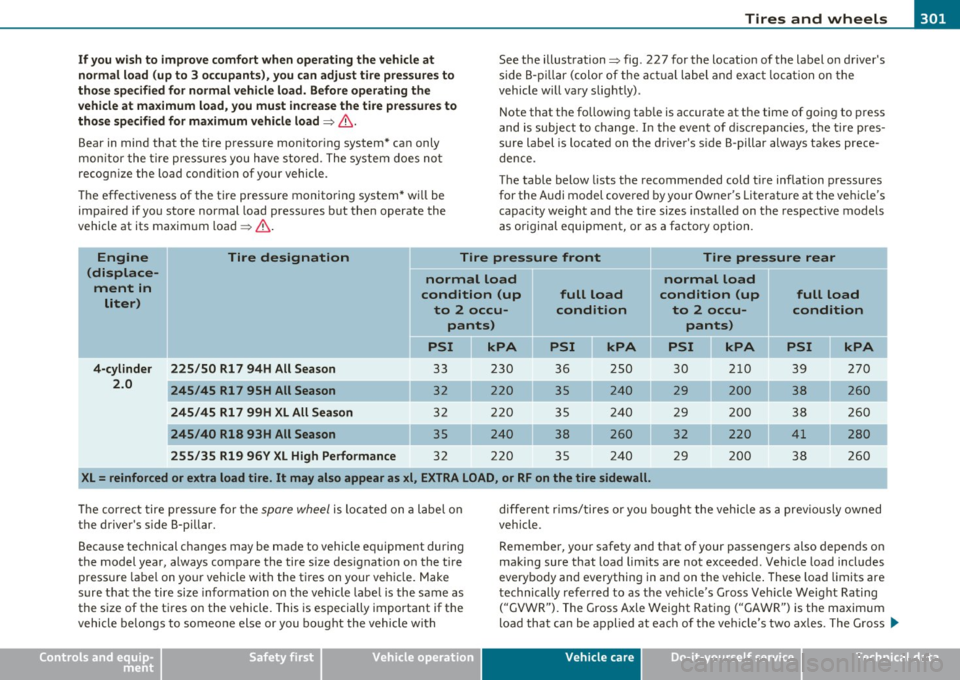
__________________________________________________ T_i_ r _e _s_ a_ n_ d_ w_ h_e_ e _ l_s __ _
If you wish to improve comfort when operating the vehicle at
normal load (up to 3 o ccupant s), you can adjust tire pres sures to
those specified for normal vehicle load . Before operating the
vehicle at maximum lo ad, you must increase the tire p res sures to
those specified for maximum vehicle load=>& .
Bear in mind that the tire press ure monitor ing system* can only
mon itor the t ire pressu re s you h ave sto red . T he sys tem does no t
recogn ize the load cond it ion of your vehicle.
Th e effectiveness of the ti re pressure monitoring system* wi ll be
impa ired if you store normal load pressu res but then operate the
vehicle at its maxim um loa d=> & . See the
illustration=> fig. 227 for the location of the label on driver's
side B- pillar (colo r of the act ual la bel and ex act l ocation on the
vehicle will vary slig htly).
N ote that the fo llow ing tab le is accurate at the time of going to press
and is subjec t to change. I n the even t of discrepancies , the tire pres
sure label is located on the driver 's side B-pillar always takes prece
dence .
T he table below lists the recommended cold t ire inflation pressures
for the Audi model covered by your Owne r's Literature at t he ve hicle's
capac ity weight and the tire sizes insta lled on the respective models
as original equipment, or as a factory option .
Engine Tire designation Tire pressure front Tire pressure rear
(displace- normal load normal load
ment in
liter) condition (up
full load condition (up
full load
to 2 occu- condition to 2 occu- condition pants) pants)
kPA PSI PSI kPA PSI kPA
4-cylinder 225/50 Rl 7 94H All Season
33 230
36 250
30 2
10 39 270
2.0 245/45
Rl 7 95H All Season 32 220 35 240
29 200 38 260
245/45
Rl 7 99H XL All Season 32 22 0 35 240 2 9 200 3 8 260
245 /40 R18 93H All Sea son 35 240 38 260 32 220 41 280
255/35 R19 96V
XL High Performance 32 220 35 240
29 200 38 260
XL= reinforced or extra load tire . It may also appear as xl , EXTRA LOAD, or RF on the tire sidewall .
The correct tire p ress ure for t he spare wheel is loca ted on a labe l o n
the driver 's s ide B-pillar.
Beca use technical c hanges may be made to vehicle equipment dur ing
the model year, always compare the tire size des ignation on the t ire
pressu re labe l on yo ur vehicle with the t ires on your vehicle. Make
sure that the tire size informat ion on t he v ehicle labe l is the same as
the size of the t ires o n the vehicle. This is especially important if the
vehicle belo ngs to so meone else or you bo ug ht the vehicle with
Safety first
differe nt r im s/ tires or you bo ugh t the vehicle as a prev iously owned
vehicle.
Remember, yo ur safety and t hat of your passengers also depends o n
making sure that load limits are not exceeded. Vehicle load includes
everybody and everything in an d on the vehi cle. These load limits are
t e chnically refer red to as the veh icle's G ross Veh icle Weig ht Rating
("GVW R"). The Gross Axle Weight Rati ng ("GAWR") is the maximum
load tha t can be applied at ea ch of the ve hicle's two ax les . T he G ross ..
Vehicle care Technical data
Page 312 of 364

-~_T_ i_ re _ s_ a_n _ d_ w_ h _e_ e_ ls _________________________________________________ _
& WARNING (conti nu ed )
• Alway s use tire s, rim s and wheel bolts that meet the specifica
tions of original factory-installed tires or other combinat ions that
have been specifically approved by the vehicle manufacturer .
• Tires age even if they are not being used and can fail suddenly,
especially at high speed s. Tires that are more than 6 years old can
only be used in an emergency and then with special care and at
lower speeds.
• Never mount used tir es on your vehicle if you are not sure of
their "previous history. " Old used t ires m ay have been damaged
even though the damage cannot be seen that can lead to sudden
tire failure and loss of vehicle control.
• All four wheels must be fitted with radial tires of the same
type , size (rolling circumference) and the same tread pattern .
Driving with different tire s reduces vehicle handling and can lead
to a loss of control.
• If the spare tire is not the same as the tires that are mounted
on the vehicle - for example w ith winter tires - only use the spare
tire for a short period of time and drive with extra care. Refit the
normal road wheel as soon as safely possible.
• Never drive fa ster than the maximum speed for which the tires
on your vehicle are rated because ti re s that are driven faster than
their rated speed can fail suddenly.
• Overloading tire s cause heat build-up, sudden tire failure,
including a blowout and sudden deflation and loss of control.
• Temperature grades apply to tires that are properl y inflated
and not over or underinflated.
• For technical reasons it is not always possible to u se wheels
from other veh icles- in some cases not even wheels from the same
vehicle model.
• If you install wheel tr im discs on the vehicle wheels , make sure
that the air flow to the brakes i s not blocked . Reduced airflow to
the brakes can them to overheat, increasing stopping distances
and cau sing a collision.
& W ARNING (continued )
• Run flat ti res may only be used on vehicles that were equipped
with them at the factory. The vehicle must have a chassi s designed
fo r run flat tires and a factory-installed tire pressure monitoring
system* that indicates a loss of tire pressure. Incorrect use of run
flat tires can lead to vehicle damage o r accidents. Check with an
authorized Audi dealer or tire speciali st to see if your vehicle can
be equipped w ith run flat tires . If run flat t ires are used , they must
be installed on all four wheels. Mixing tire types is not permitted.
0 Note
• F or tech nical reasons, it is no t gene rally poss ible to use the wheel
r ims from other vehicles . This ca n hold t rue for w heels of the same
veh icle type .
• If the spare tire is different from the tires th at you have mou nted
on yo ur vehi cle (fo r ex am ple w inte r tir es o r wide profile tires), then
use the spa re t ire for a short period of time on ly and d rive with extra
care . Replace t he f lat tire w ith the tire matching the others on your
veh icle as soon as possible.
• N ever dr ive witho ut the valve s te m c ap. The valves coul d get
damaged .
'£> For the sake of the environment
Dispose of old t ires in accordance with the loca l req uirements.
(]] Tips
Tires with t he ident ification "AO" have been specially matched with
your Audi. We recommend us ing only these ti res beca use they meet
t he highest standa rds rega rding saf ety and dr iv ing c ha racteristics
when used correct ly. You r autho rized Audi dealer w ill gladly provide
you with more info rmation. •
Page 314 of 364
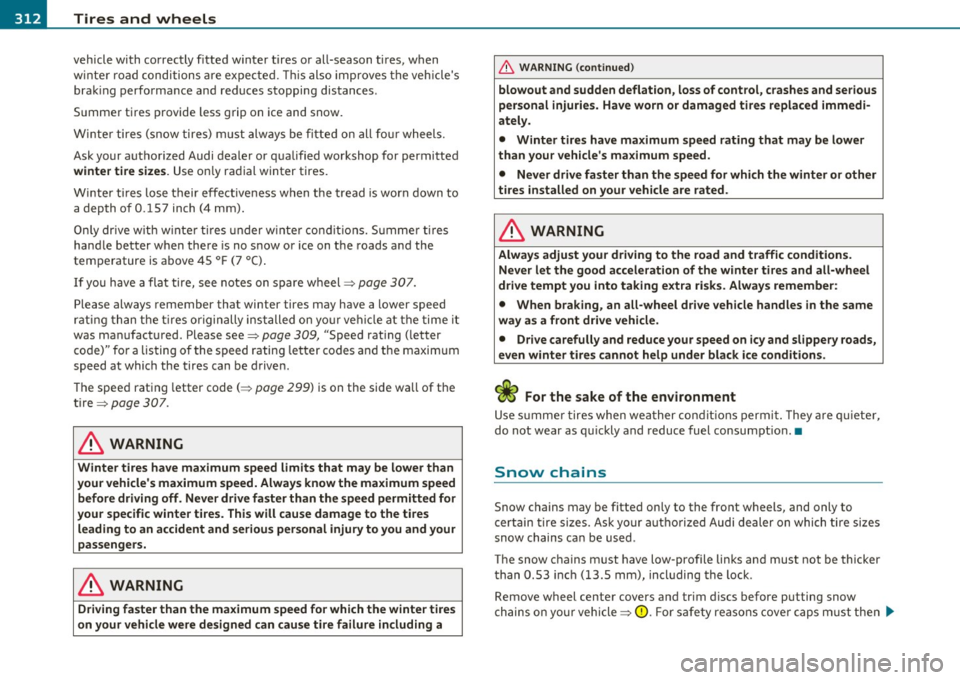
Ill Tires and wheels
-------------------
vehicle with correctly fitted w inter t ires or all -season ti res, when
w inte r road condi tio ns ar e ex pect ed . Thi s also improve s the veh icle's
brak ing perfo rma nce and reduces stopping distances .
S umme r tires provide less g rip on ice and snow.
Wint er ti re s (sn ow tire s) m ust alway s b e fi tted on a ll fo ur wheel s.
Ask your aut horized Audi dea le r or qualified workshop for permitted
winter tire sizes. Use on ly ra dial winter tires .
Wint er tires lose their effe ct iveness w hen the tread is wor n down to
a depth of 0.1 57 inch (4 mm).
O nly dr ive w it h w inte r tir es und er w inte r co ndition s. Summe r tires
hand le better w hen there is no s now o r ice on t he roads and the
temperature is a bove
4 5 °F (7 ° C ).
If y ou have a flat tire, see notes on s pare wheel ~
page 307.
Please always remember that winter tires may have a lower speed
r a tin g th an th e t ires origin ally inst alled on y our vehicl e a t th e time it
was man ufact ured , Please see::::;, page 309, "Spe ed rat ing ( letter
c ode)" fo r a listing o f the speed ra ting le tte r codes and t he maxim um
speed at which the tires can be driven.
T he spee d rat ing letter code( ~
page 299) is on the side wa ll of the
ti re ::::;,
page 3 0 7.
& WARNING
Winter tires have maximum speed limits that may be lower than
your vehicle's maximum speed. Always know the maximum speed
before driving off. Never drive faster than the speed permitted for
your specific winter tires. This will cause damage to the tires leading to an accident and serious personal injury to you and your
passengers.
& WARNING
Driving faster than the maximum speed for which the winter tires
on your vehicle were designed can cause tire failure including a
& WARNING (co ntinued )
blowout and sudden deflation , loss of control, crashes and serious
personal injuries . Have worn or damaged tire s replaced immedi
ately.
• Winter tires have maximum speed rating that may be lower
than your vehicle's maximum speed.
• Never drive fa ster than the speed for which the winter or other
tires installed on your vehicle are rated.
& WARNING
Always adjust your driving to the road and traffic conditions.
Never let the good acceleration of the winter tires and all-wheel
drive tempt you into taking extra risks . Always remember:
• When braking, an all-wheel drive vehicle handles in the same
way as a front drive vehicle.
• Drive carefully and reduce your speed on icy and slippery roads,
even winter tires cannot help under black ice conditions .
For the sake of the environment
Use summe r tires when wea ther co nd itio ns perm it. They are qui ete r,
do not wear as quickly and reduce fuel consumpt io n. •
Snow chains
Snow chains may be fitted on ly to th e fro nt wheels, and only to
c er ta in tire siz es. As k yo ur a uth orized Audi de aler on which ti re si zes
snow c hains ca n be used .
The snow c hains m ust have low-profile lin ks an d must not be thicker
t han 0.53 inch (1 3.5 mm), including the lock.
Remove wheel center covers and trim d iscs before putting snow
c hains on you r veh icle ::::;,
0. For safety rea so ns co ve r caps m ust t he n ~
Page 315 of 364

Tires and wheels -______________________ Effll
be fitted ove r th e wheel bo lts . These a re available from a uthorized
Au di d eal er s.
& WARNING
Using the wrong snow chains for your vehicle or installing them
incorrectly can increase the risk of loss of control leading to
serious personal injury.
• Snow chains are available in different sizes . Always make sure
to follow the instructions provided by the snow chain manufac
turer.
• When driving with snow chains never drive faster than the
speed permitted for your specific snow chains.
• Always observe local regulations.
0 Note
• Remove snow chains befor e driving on roads not covered w it h
snow to avoid dama gin g tir es and wearing t he snow chai ns dow n
unnece ssaril y.
• Snow chains, which come into direct contact with t he wheel rim,
can scratch o r damag e it. Ther efore, ma ke sure th at th e snow cha ins
are suitably covered. C hec k the pos it io n of the snow cha ins afte r
dr iv in g a few yar ds and correct if ne ce ssa ry . Fo llo w the i nstructions
from t he snow chain ma nufact urer w hen doing so.
[ i ] Tips
W here snow c hains are mandatory on certain roads, this no rmally
a lso a ppl ies to vehicl es wi th a ll w hee l dr ive . •
Safety first
Wheel bolts
Whe el bolts must alway s be tight en ed to th e corre ct
to rqu e.
T he design of wheel bolts is matche d to the fac to ry installed rims. If
differe nt rims ar e fitte d, the cor rec t wheel bolts with the r ight length
and co rrectly s haped bolt hea ds must be used. Th is ensures that
w heel s are fitted s ecur ely and that t he brak e sys te m fun ction s
correctly .
I n certai n circumstances, yo u may not use wheel bolts from a
different veh icle -even if it is th e sam e mode l~
page 345.
& WARNING
Improperly tightened or maintained wheel bolts can become
loose causing loss of control, a collision and serious personal
injury .
• Always keep the wheel bolts and the thread s in the wheel hubs
clean so the wheel bolts can turn easily and be properly tightened.
• Never grease or oil the wheel bolts and the threads in the wheel
hubs. They can become loose while driving if greased or oiled, even
if tightened to the specified torque.
• Only use wheel bolts that belong to the rim being installed.
• Never use different wheels bolts on your vehicle.
• Always maintain the correct tightening torque for the wheel
bolts to reduce the risk of a wheel loss. If the tightening torque of
the wheel bolts is too low , they can loosen and come out when the
vehicle is moving. If the tightening torque is too high, the wheel bolts and threads can be damaged and the wheel can become
loose .
0 Note
The sp eci fied tor qu e for th e wheel bolts i s 90 ft lb ( 120 Nm) wi th a
tole rance of ± 7,4 ft lb( ± 10 Nm). Torque wheel bo lts diagonally. .,_
Vehicle care Technical data
Page 316 of 364
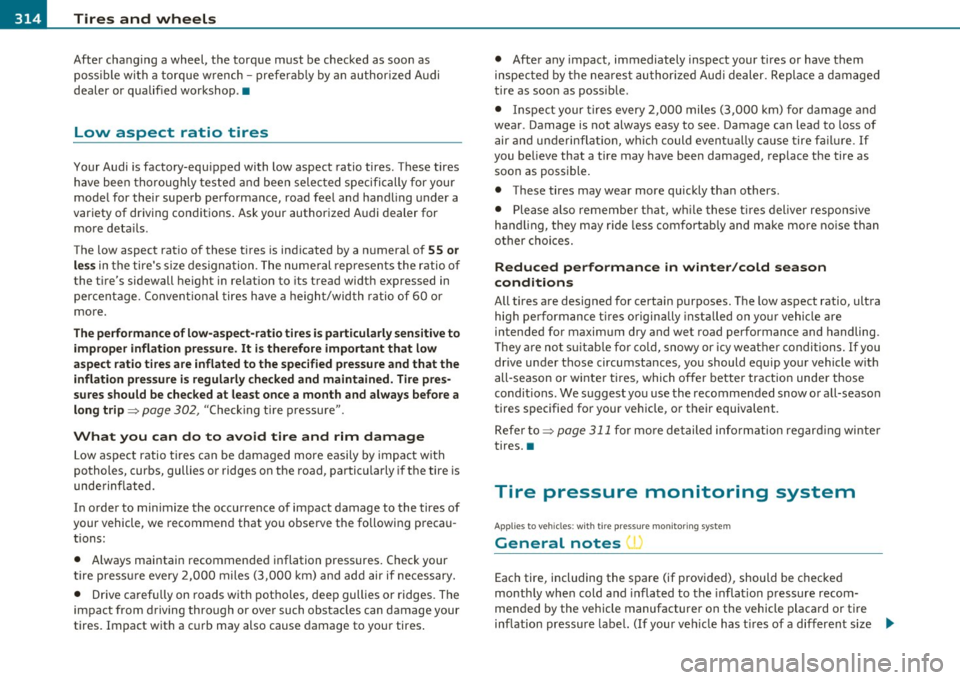
___ T_ ir_e_ s _ a_ n _ d_ w_ h_e_ e_ ls _______________________________________________ _
After changing a wheel, the torque must be checked as soon as
possible with a torque wrench -preferably by an authorized Audi
dealer or qualified workshop. •
Low aspect ratio tires
Your Audi is factory-equipped with low aspect ratio tires. These tires
have been thoroughly tested and been selected specifically for your
model for their superb performance, road feel and handling under a
variety of driving conditions. Ask your authorized Audi dealer for
more details.
The low aspect ratio of these tires is indicated by a numeral of
55 or
less
in the tire's size designation. The numeral represents the ratio of
the tire's sidewall height in relation to its tread width expressed in
percentage. Conventional tires have a height/width ratio of 60 or
more.
The performance of low-aspect-ratio tires is particularly sensitive to
improper inflation pressure. It is therefore important that low
aspect ratio tires are inflated to the specified pressure and that the
inflation pressure is regularly checked and maintained. Tire pres
sures should be checked at least once a month and always before a
long trip=>
page 302, "Checking tire pressure" .
What you can do to avoid tire and rim damage
Low aspect ratio tires can be damaged more easily by impact with
potholes, curbs, gullies or ridges on the road, particularly if the tire is
underinflated.
In order to minimize the occurrence of impact damage to the tires of
your vehicle, we recommend that you observe the following precau
tions:
• Always maintain recommended inflation pressures. Check your
tire pressure every 2,000 miles (3,000 km) and add air if necessary.
• Drive carefully on roads with potholes, deep gullies or ridges. The
impact from driving through or over such obstacles can damage your
tires. Impact with a curb may also cause damage to your tires. •
After any impact, immediately inspect your tires or have them
inspected by the nearest authorized Audi dealer. Replace a damaged
tire as soon as possible.
• Inspect your tires every 2,000 miles (3,000 km) for damage and
wear . Damage is not always easy to see. Damage can lead to loss of
air and underinflation, which could eventually cause tire failure. If
you believe that a tire may have been damaged, replace the tire as
soon as possible.
• These tires may wear more quickly than others.
• Please also remember that, while these tires deliver responsive
handling, they may ride less comfortably and make more noise than
other choices.
Reduced performance in winter/cold season
conditions
All tires are designed for certain purposes. The low aspect ratio, ultra
high performance tires originally installed on your vehicle are
intended for maximum dry and wet road performance and handling.
They are not suitable for cold, snowy or icy weather conditions. If you
drive under those circumstances, you should equip your vehicle with
all-season or winter tires, which offer better traction under those
conditions. We suggest you use the recommended snow or all-season
tires specified for your vehicle, or their equivalent.
Refer to=>
page 311 for more detailed information regarding winter
tires. •
Tire pressure monitoring system
Applies to veh icles: w ith tire pressure monitoring system
General notes '
Each tire, including the spare (if provided), should be checked
monthly when cold and inflated to the inflation pressure recom
mended by the vehicle manufacturer on the vehicle placard or tire
inflation pressure label. (If your vehicle has tires of a different size .,